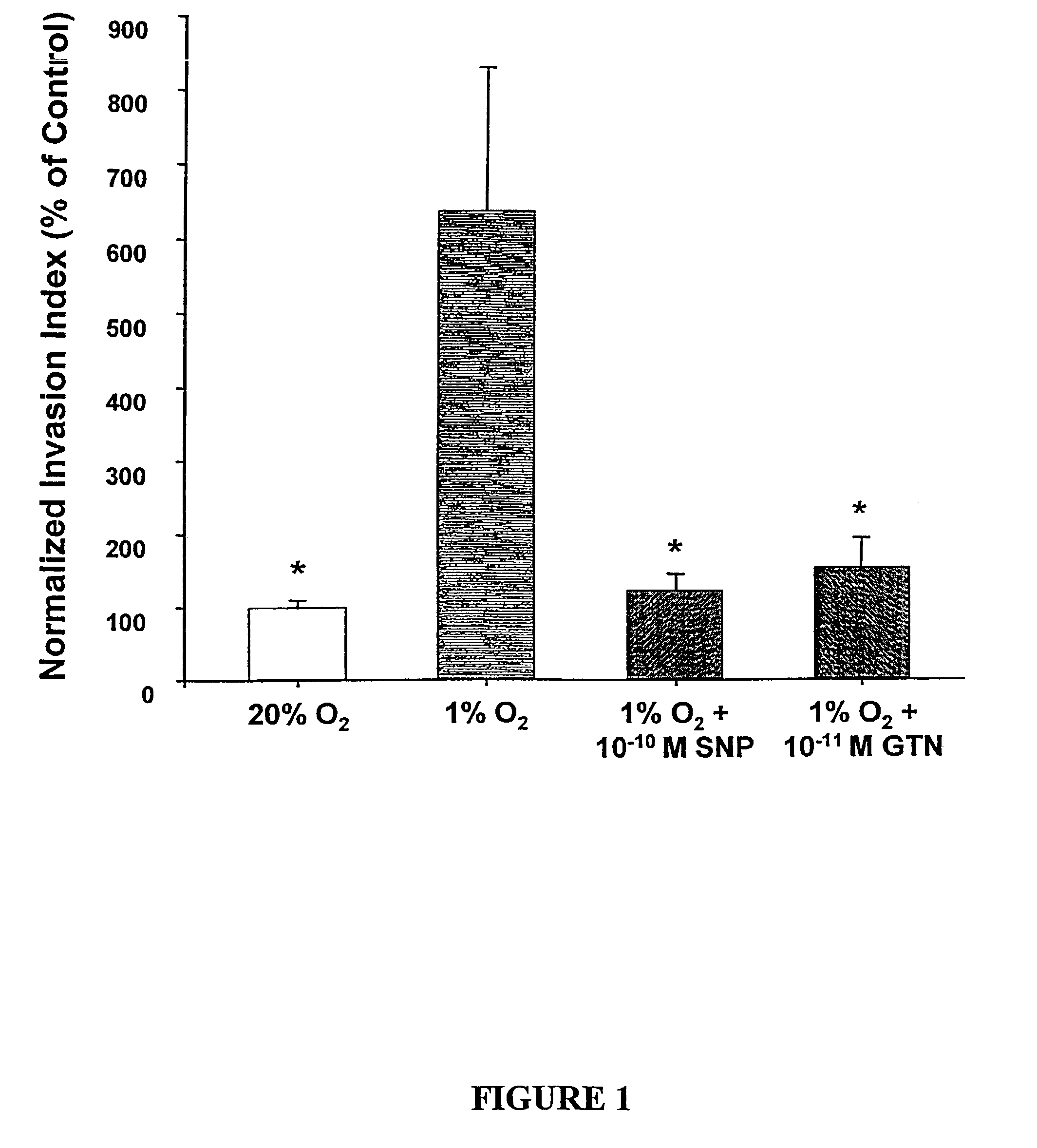Formulations and methods of using nitric oxide mimetics against a malignant cell phenotype
a technology of nitric oxide and mimetics, which is applied in the direction of biocide, drug composition, phosphorous compound active ingredients, etc., can solve the problems of cytostasis and apoptosis, alterations in gene expression, etc., and achieve the effects of reducing tumor volume, reducing cancer markers, and prolonging cancer remission
- Summary
- Abstract
- Description
- Claims
- Application Information
AI Technical Summary
Benefits of technology
Problems solved by technology
Method used
Image
Examples
example 1
I. Example 1
Materials and Methods
[0176]A. Materials
[0177]Tissue culture medium (RPMI 1640) and fetal bovine serum (FBS) were purchased from Gibco BRL (Grand Island, N.Y.). Hypoxic conditions were generated using airtight chambers from BellCo Biotechnology (Vineland, N.J.). GTN was obtained as a solution (TRIDIL, 5 mg ml−1 or 2.22 M) in ethanol, propylene glycol and water (1:1:1.33) from DuPont Pharmaceuticals (Scarborough, ON). Sodium nitroprusside (SNP) was purchased from Sigma Chemical Co. (St. Louis, Mo). RNA extractions were conducted using a PURESCRIPT RNA isolation kit from Gentra Systems (Minneapolis, Minn.). For the Northern blot analyses, the nylon membranes used for the RNA transfers were purchased from Micron Separations, Inc. (Westboro, Mass.); the uPAR and PAI-1 cDNA probes were cloned in a Bluescript plasmid vector; the [32P]-dCTP and the Reflection NEF film were purchased from Dupont / New England Nuclear (Mississauga, ON); and the oligolabelling kit was obtained from P...
example 2
II. Example 2
The Activation of sGC and PKG is Linked to the Regulation of Invasive and Metastatic Phenotypes
[0200]A. Materials
[0201]Glyceryl Trinitrate (GTN) at a concentration of 2.22 M (Sabex, Boucherville, QC) and Diethylenetriamine / nitric oxide adduct (DETA-NONOate) (SIGMA Chemical Co., St. Louis, Mo.) were used as NO-mimetics. Desferoxamine mesylate (DFO) (SIGMA Chemical Co., St. Louis, Mo.) was used as an iron chelator. 1H-[1,2,4]Oxadiazolo-[4,3-a]Quinoxalin-1-One (ODQ) (SIGMA Chemical Co., St. Louis, Mo.), was used to selectively inhibit soluble guanylyl cyclase. Various concentrations 8-bromoguanosine 3′:5′-cyclic monophosphate (8-Br-cGMP) (SIGMA Chemical Co., St. Louis, Mo.) were used to activate cGMP-dependent protein kinase (PKG), and KT5823 (Calbiochem, La Jolla, Calif.) was used to selectively inhibit PKG.
[0202]B. Cells
[0203]The HTR-8 / SVneo line was established from explant cultures of human first trimester placenta and was immortalized by transfection with the large T ...
example 3
III. Example 3
The Role of Nitric Oxide in Hypoxia-Induced Chemoresistance in Prostate Cancer Cells
[0244]Low tumor oxygenation (hypoxia) correlates with increased metastasis and resistance to radiotherapy and chemotherapy. Hypoxia has been shown to be associated with human prostate cancer, and prostate cancers are often highly resistant to chemotherapy. To test whether hypoxia is a major contributor to reduced chemosensitivity in prostate cancer cells and that hypoxia-induced chemoresistance in prostate cancer cells can be inhibited by low concentrations of nitric oxide (NO) mimetic agents, human PC-3 and mouse TRAMP-C2 prostatic adenocarcinoma cells were incubated in 20% O2 or 0.5% O2 for 12 hours in the presence or absence of glyceryl trinitrate (GTN, 0.1 nM). This was followed by a one-hour incubation with doxorubicin and survival was assessed by colony formation assays. Western blot analysis was used to measure NO synthase (NOS) protein levels in cells cultured in 20% and 0.5% O2...
PUM
| Property | Measurement | Unit |
|---|---|---|
| Level | aaaaa | aaaaa |
| Selectivity | aaaaa | aaaaa |
Abstract
Description
Claims
Application Information
 Login to View More
Login to View More - R&D
- Intellectual Property
- Life Sciences
- Materials
- Tech Scout
- Unparalleled Data Quality
- Higher Quality Content
- 60% Fewer Hallucinations
Browse by: Latest US Patents, China's latest patents, Technical Efficacy Thesaurus, Application Domain, Technology Topic, Popular Technical Reports.
© 2025 PatSnap. All rights reserved.Legal|Privacy policy|Modern Slavery Act Transparency Statement|Sitemap|About US| Contact US: help@patsnap.com



